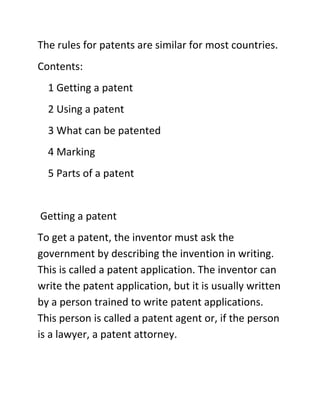
Rules for patents in most countries
- 1. The rules for patents are similar for most countries. Contents: 1 Getting a patent 2 Using a patent 3 What can be patented 4 Marking 5 Parts of a patent Getting a patent To get a patent, the inventor must ask the government by describing the invention in writing. This is called a patent application. The inventor can write the patent application, but it is usually written by a person trained to write patent applications. This person is called a patent agent or, if the person is a lawyer, a patent attorney.
- 2. The government does not usually just give the inventor a patent. Instead, the government tries to confirm whether the idea is actually new. This is called patent examination. The government will try to find books, stories, or even other patents that show that the idea was not new. The inventor, or his or her patent attorney, then try to show how the inventor's idea is different from anything that the government finds. If the government finds that the inventor's idea is new and useful, it will publish the patent. The government will also send the inventor a copy of his or her patent application with a special seal. This copy is the patent. The inventor must also pay the government a tax to get a patent. Usually, an inventor pays money to ask for the patent, and the inventor pays money when
- 3. he or she gets a patent. In some countries, the owner of a patent must also pay money to keep the patent. Some can be cheap and some can be expensive. Using a patent The owner of a patent can stop other people from using their idea. If someone other than the patent owner uses the patent, this is called infringing a patent. If the owner knows that someone is infringing his or her patent, the patent owner can ask a court to stop them. If the court agrees that the other person was using the patent, the court can make that person pay a fine to the patent owner. The patent owner can give other people permission to use their patent. This is called a license. The person that wants to use another person's patent will usually pay money to the patent owner. What can be patented
- 4. Patents most often cover products or processes that contain ‘new’ functional or technical ideas. They are concerned with how things work, how they are made or what they are made of. Patents cover many different things such as electronics, medicines, agriculture and transport – anything in fact from a small detail in an electric switch to an entire power station. Marking Often a product is marked with a text saying 'patent pending’ or 'pat. pending', which means that a patent has been asked for (part of) the product. Then people are warned that they should not copy the invention. Parts of a patent Patents are usually very long. They include a number of smaller parts. A patent usually includes a section that briefly describes the idea called the abstract. It also may include a section that describes other people's inventions and how the inventor's
- 5. idea is different called the "background of the invention." The patent also includes a long description of the idea itself called a "detailed description." In this section, the inventor tries to describe every detail of his or her invention. The patent also has a number of pictures called the "figures." The figures are usually drawn by people called draftsman that are trained to draw in a special way. The pictures are labeled with numbers to show different parts of the invention. At the end of most patents is a section called the claims. These are usually numbered. They include the a short statement that lists all of the things needed for the invention. A court will use the claims
- 6. to decide if another person is "infringing the patent."
